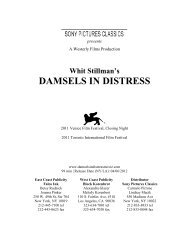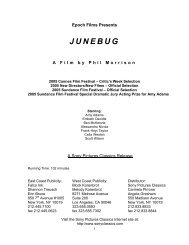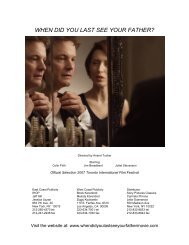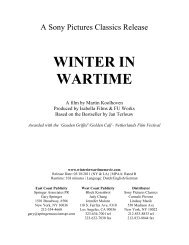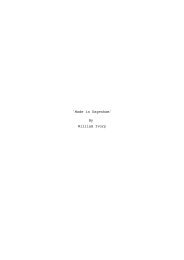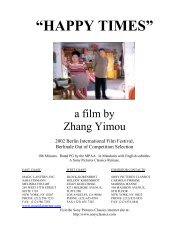BARNEY'S VERSION - Sony Pictures Classics
BARNEY'S VERSION - Sony Pictures Classics
BARNEY'S VERSION - Sony Pictures Classics
You also want an ePaper? Increase the reach of your titles
YUMPU automatically turns print PDFs into web optimized ePapers that Google loves.
for the project. "That resourcefulness,‖ he says, ―that deep desire is the kind that Barney himself<br />
would have." Ultimately, Lewis' understanding and love for Richler's characters played a large<br />
part in convincing Lantos to let Lewis direct the film. "He had tremendously intimate<br />
knowledge of these characters," says Lantos, "He understood them as well as I did."<br />
About three years ago, a friend of Lantos' came across a young screenwriter, Michael Konyves,<br />
whom he thought would be perfect for <strong>BARNEY'S</strong> <strong>VERSION</strong>, and recommended him to the<br />
producer. A meeting ensued and, as Konyves recalls, "I was allowed five minutes in the room<br />
with Robert to give my pitch." Lantos not only heard the writer out, he gave him a previous draft<br />
and asked Konyves for notes. "I took a month," he says," and wrote an entire treatment for him.<br />
I think he was expecting a few notes on the draft, not a whole treatment for an entirely new and<br />
radical way of structuring the movie out of that massive book!" What Lantos didn't know was<br />
that Konyves, like him and Lewis, was equally obsessed with <strong>BARNEY'S</strong> <strong>VERSION</strong>. "You<br />
can't be from Montreal and Jewish and not know Mordecai Richler," he says. "He's just such a<br />
huge part of this city. Coming from Montreal, and growing up in the very neighborhood he<br />
writes about, you connect with it. That's just one of the reasons why I identified with the book."<br />
Konyves goes on to say that BARNEY’S <strong>VERSION</strong> is the only book he's ever read twice and<br />
that, once he had re-read it, he had to pursue the possibility of adapting it to the screen. "It got<br />
me interested in finding out who had the rights to it, which began a very long series of events<br />
that led me to Robert Lantos. I didn't know he had a long history with the project," the young<br />
screenwriter confesses, ―or that he'd been working on it for ten years. I was so naive about the<br />
situation; I didn't know there had been so many incarnations of it, and so many writers and drafts<br />
before I got there. I just came in fresh, as if it were a new project," he observes, "and, although<br />
the script went through many more incarnations – we worked consistently for two years on it –<br />
the initial structure I proposed in my treatment is the existing structure of the movie."<br />
"We brought Michael in," recalls Lewis,‖ and he did his own version, which was far superior to<br />
mine." Lantos notes Konyves "found a way to take this very long, sprawling novel with its many<br />
subplots – it flashes forward, it flashes backwards, it has a huge cast – and he actually found the<br />
heart." Konyves adds, "It‘s hard to condense these characters in the book, who have so much life<br />
and vitality, to the short amount of time that you're allowed in a feature film. You have to make<br />
sure that there's not a moment, not a second, that's wasted. When you're reading the book," he<br />
notes, ―it‘s a solitary experience. You sit at home, you spend days, weeks, sometimes months if<br />
you're a slow reader, whereas, with the movie, you're there for two hours and you're participating<br />
in the narrative in a very different way." Lantos credits Konyves with translating the novel from<br />
written to cinematographic form, and with creating a visual narrative to function in place of the<br />
literary one. "Michael eliminated the narration," Lantos says, "along with all the other literary<br />
devices that Richler used in the book. He found visually exciting ways to tell the story, and<br />
scenes that might take twenty-five pages in print are now rendered in thirty seconds of screen<br />
time. He found what I would call a 'cinematic language'." Lewis adds that, while Richler's plot<br />
required a lot of surgery, his characters transferred well from page to screen. "Michael pared<br />
away a lot of the anecdotal material that exists in the book, much of which is hilarious and funny<br />
as hell. But the characters were always clearly filmic and really well-drawn, beautifully drawn."<br />
7



